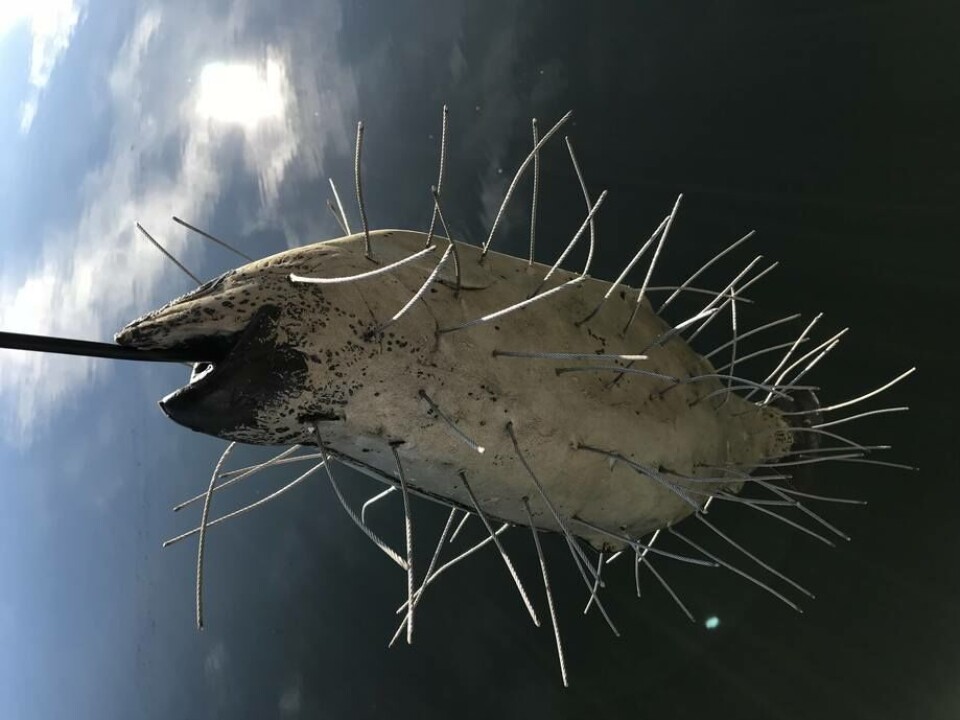
Charging forward: Ace Aquatec offers electric fish to North America
It’s not most people’s idea of a handsome salmon, but for aquaculture electronics supplier Ace Aquatec the “electric fish” may well be a thing of beauty.
The Dundee company is introducing the non-acoustic predator deterrent to overseas customers at Seafood Expo North America in Boston at the weekend and hopes it will eventually sell hundreds in areas where which have tight restrictions on acoustic deterrent devices (ADDs).
“It started as a one-off project for a site encountering deaf seals but then with the success during those trials we continued R&D to turn it into a new addition to our range of predator deterrents,” said Ace Aquatec’s sales and marketing head, Mike Forbes.

Hoping for hundreds
“Loch Duart have been using the electric fish at a couple of different sites since November last year and we plan to combine it with our other acoustic systems in Scotland as well as using an electric-only approach in markets with restrictions on acoustic devices.
“We have a few dozen in production right now to meet current demand and hope to have hundreds in the water over the next couple of years.”
The electric fish is designed to look like a dead salmon and is placed at the bottom of a net pen. When a predator attempts to eat the mort it gets an electric shock from the electrodes sticking out of the fish, which are hard for it to see in the relative darkness of the cage bottom.
In-water stunner
Although originally developed to deter older seals that had become hard of hearing and weren’t put off by ADDs, Ace Aquatec has seen the opportunity to export it to countries such as the US, Canada and New Zealand which have tight restrictions on the use of acoustic devices.
It will be Ace Aquatec’s first time exhibiting at the event, and it will also be introducing its award-winning in-water Humane Stunner Universal (HSU) to the North American market.
Forbes said: “The number of farms shifting to in-water electric stunning has expanded rapidly over the last couple of years. We’ve also been stunning salmon for the SSRAA (Southern Southeast Regional Aquaculture Association) in Alaska, for over a year, and we’re hoping that the Boston Seafood Expo will help us expand usage to other parts of North America.
“Everybody has their own unique reasons for making the shift to in-water electric stunning. I’m looking forward to finding out what the biggest drivers are for the people that we meet in Boston.”

Scottish provenance
Two Scottish salmon producers – Wester Ross Salmon and the Scottish Salmon Company (SSC) – will also be exhibiting at Seafood Expo North America (SENA), which runs from this Sunday until Tuesday, March 19. Both have a significant customer base in the US.
SSC’s sales in North America have grown six-fold in the last two years, which it attributes to an increasing demand for quality, traceability and Scottish provenance.
Last year it used the Expo to launch its Lochlander salmon brand, targeted specifically at the US restaurant trade.
‘Perfect moist texture’
Wester Ross travels to Boston buoyed by jointly winning a taste comparison in the Boston Globe, which wrote that the niche producer’s product “is everything salmon should be: perfect moist texture, delicious flavor that tastes of the sea, almost buttery. This topped our list of favorites, along with [Hidden Fjord salmon from the] Faroe Islands".
The salmon farmers will be sharing a Scottish area – stand 2253 - with trout grower Dawnfresh, as well as Loch Fyne Oysters, Seafood Scotland and fishers’ cooperative Scottish Seas.
Ace Aquatec will be on stand 1788.























































